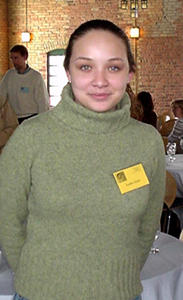
Sandra Alcala
Thesis Title:
Investigation of the Intranasal Delivery Method as a Means of Targeting Therapeutic Agents to the Injured Retina and Optic Nerve
Current Position:
Senior Vice President, Avōq, Washington D.C.
Former Positions:
Government Relations, Subject Matter
Chief of Staff, Congressman Filemon Vela; House of Representatives
Policy Director, United States House of Representatives
Legislative Assistant, U.S. House of Representatives
Undergraduate Institution and Major/Degree:
Our Lady of the Lake University, BA, Psychology
Major Advisor(s):
Linda McLoon, Ph.D.
Research Description:
Anterior ischemic optic neuropathy (AION) is a devastating ocular disease caused by disruption in arterial blood supply to the optic nerve head. This loss of oxygenation by interruption of the blood supply results in ischemic injury to the retinal ganglion cells and their axons, resulting in loss of visual field and decrease of visual acuity. The incidence of this disease is 2.3-10.3 per 100,000 in the US. The risk for development of AION on the fellow eye in affected patients is estimated to be 15-25%. There is no effective treatment for this condition. In addition, while the etiology of glaucoma is not well understood, there is increasing evidence that blood flow at the optic nerve head plays a role in development and progression of disease pathophysiology. Risk of disease is increased when ophthalmic artery flow rates decrease. We use a rodent model shown to produce a transient ischemia in the retina and optic nerve. These injuries result in significant but transient oxygen loss of the optic nerve, and by 5 months over half of the optic axons degenerate.
Intranasal drug application produces almost instant drug delivery to brain structures with little evidence of systemic spread. It is non-invasive and easy to perform This method was effective for the treatment of an animal model of focal brain ischemia. We are examining if intranasal administration of insulin growth factor-1 and/or erythropoietin can rescue retinal ganglion cells and optic axons that have been exposed to transient ischemia. We produce a transient ischemic injury to the retina and optic nerve in adult rats using a model of coagulopathy-induced ischemia followed by intranasal application of insulin growth factor-1, erythropoietin, and other neurotrophic agents. We will determine if intranasal IGF-1 and/or erythropoietin administration will rescue of ganglion cells and optic axon from injury and loss.
Lab Rotations:
- Kelvin Lim
- Hossein Fatemi
- Angus MacDonald
- Linda McLoon
Conferences Attended:
- Society for Neuroscience annual meeting - Fall 2003
Selected Publications:
- Alcala-Barraza SR, Lee MS, Hanson LR, MacDonald A, Frey WH, McLoon LK . Intranasal delivery of neurotrophic factors BDNF, CNTF, EPO and NT-4 to the CNS. J Drug Targeting 2010;18:179-190.
- Danylkova NO, Alcala SR, Pomeranz HD, McLoon LK. Neuroprotective effects of brimonidine treatment in a rodent model of ischemic optic neuropathy. Exp. Eye Res. 2007;84:293-301.
- Danylkova NO, Pomeranz HD, Alcala SR , McLoon LK. Histological and morphometric evaluation of transient retinal and optic nerve ischemia in rat. Brain Res. 1096:20-29, 2006.
- Alcala SR, Danylkova N, Hoekman J, Hanson L, Frey W, McLoon LK. Intranasal delivery of insulin-like growth factor-1 to the optic nerve and retina in the rat. Invest. Ophthalmol. Vis. Sci. ARVO Abst. 47:728, 2006.
Awards and Honors:
- 2006 Travel Grant Award from the Community of Scholars Program to attend the Annual Biomedical Research Conference for Minority Students.
- 2007 Travel Grant Award from the Association for Research in Vision and Ophthalmology (ARVO) to attend the 2007 ARVO Research Conference.
